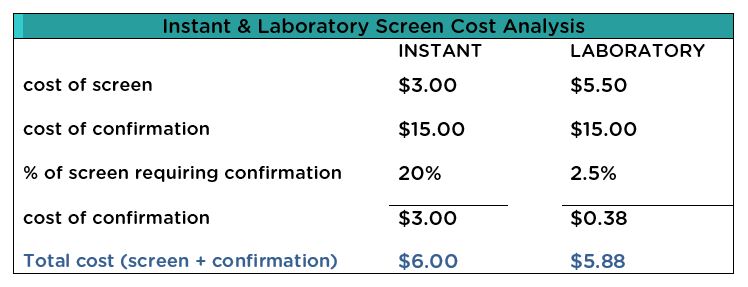Instant screen or laboratory screen? How do you choose the best drug testing method to better monitor the clients on your caseload? Read on to learn more about the two screening methods and when it’s recommended to use them.
When you rely on frequent, random tests to monitor drug and alcohol use, screening tests are a fast and inexpensive way to know if whether or not clients are abstaining from new substance use. To determine the best option for your program consider the following factors:
- Who will collect the sample?
- Who will create and manage the testing schedule?
- How will you ensure the schedule is random and that clients have an equal chance of testing on any given day?
- Are the results objective and defensible in court?
- Do clients, the court, or others require confirmation tests?
INSTANT TESTS
Hidden costs
Many choose point-of-care cups or instant tests because of low price, which ranges from $3 to $15, depending on the substances on the panel. Unfortunately, this low ‘teaser’ price comes with hidden costs, such as false negatives and more confirmation testing. Instant tests often miss new substance use or are unreliable in detecting certain substances like illicit fentanyl or alcohol. These false negatives endanger your clients and public safety. A high rate of false positives requires confirmation testing for about 20% of instant screens compared to less than 3% for laboratory screens.

Staff Time
How many hours each week does your staff – probation officers, treatment providers, or court personnel – spend collecting samples? When you factor in the cost of the time spent collecting samples and interpreting results, you can easily add several dollars to the cost of each test. Having criminal justice and treatment professionals collecting samples also increases staff turnover, reduces staff morale, and can create a conflict of interest, not to mention the “yuck” factor.
Accuracy
When it comes to sensitivity and specificity, point-of-care instant tests are variable − meaning the test may not react to all drugs within a class. They're also subjective based on the skill level of the test administrator tasked with interpreting the results. For common drugs of abuse, the variable, subjective attributes of instant screens result in a false positive or false negative result for one of four samples. A false positive reading means a drug was detected that isn’t actually there, while a false negative means the instant screen missed finding a drug that was present in a urine sample.
Point-of-care tests are limited to the number of substances that can fit on a test cup, typically about 15, and there is no way to rotate substances or customize the panel. This makes point of care tests predictable. Clients know what they are tested for and can easily choose another substance not on the panel to avoid detection.
LABORATORY SCREEN
Certified laboratories use sophisticated instruments to screen for drug metabolites. Costs for laboratory screens are comparable to instant tests, typically between $3 and $30. When you factor in the cost of confirmation testing, a comparable laboratory screen will often cost less than an instant screen.
Time
Think laboratory screen drug testing results aren’t fast? Think again! You can get test results the next business day. Plus, consider the time you’ll save your staff by outsourcing the collection and screening processes You also save time by reducing the need for confirmation tests.
Accuracy
With more accurate results, you’ll save money, because you won’t need additional confirmation testing the much-less-accurate instant screen often requires. The sensitivity of the lab equipment means fewer false positives and fewer false negatives, while instant tests provide a subjective reading that is dependent on the variable skill of the collector.
Laboratory test results are definitive, meet Daubert and Frye scientific rules of evidence, and are defensible in court.
Flexible
A unique advantage of laboratory screen testing is the ability to create a custom panel for each client, and the option to rotate the tests on the panel to cover more drugs. That means you can rotate and swap out the substances being tested for each client, considering their individual history, behavior, and other factors.
Laboratory screen testing is also compatible with most specimen types—including urine, oral fluid, hair, blood, and sweat—providing a wider range of testing options.
Expertise
Keeping up with the latest drugs of choice is a full time job, especially when clandestine overseas labs constantly tweak the formulas of fentanyl and other illicit substances. Instant tests with their fixed panels simply can’t keep up. You’ll want to choose a laboratory partner with a licensed toxicologist on staff to stay ahead of policy changes and trends in illicit substance use.
While neither test is perfect – both detect classes of drugs rather than specific substances, and both are subject to cross-reactivity, the bottom line is that laboratory tests are a better value. You get more accurate results the first time, the expertise of professional lab analysts and next business day results, often at the same or even better price than the instant screen.
If you could have the high standard of laboratory testing at the same price as you now pay for point-of-care tests, with next business day results and reduce the need for costly confirmation tests, why wouldn’t you?
Contact averhealth today to learn more, or get started by downloading our ebook on drug testing best practices.
